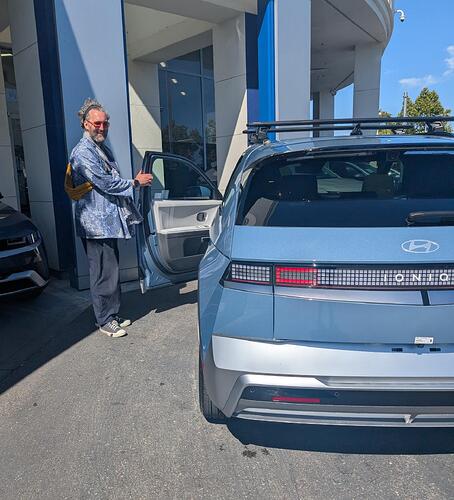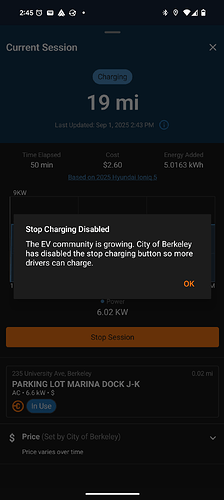Month 1 of Ionic 5 EV operation
Okay, a month into the lease and I have some thoughts. Let’s review some observations and explore where that leaves me.
Odometer: 1183 miles
The vehicle is really interesting
As a battery platform equipped as a transport device with convergent computing attributes, the 2025 Ioniq 5 is an interesting device.
I was expecting a “car, but electric.” The interfaces have a lot of trivial aspects, but there have been times when I appreciated a small detail that shows the expected feature set for modern road vehicles.
Eventually, I’ll enumerate the features and my opinion of them. Overall, I appreciate the function of the EV, and I enjoy the aspects that make it feel like I’m driving a space shuttle. 
The vehicle is dubbed evlab1, because I consider it a science and learning resource; it is technically budgeted as part of home learning for our nest.
I’ve also adapted it as a mobile office: I activated the data plan from Verizon, accessed from the vehicle’s WiFi network. I’ve had group video calls with 8 participants, no lag. While charging. And in air conditioning. 
 Oh, @maiki, tell them about charging downhill!
Oh, @maiki, tell them about charging downhill!
Oh yeah, I almost forgot (thanks  )! So, our nest has a twice-daily commute to the top of the Oakland Hills (and over in one of the most Initial D routes I’ve ever experienced!), and while returning I’ve seen the battery percentage of my EV battery rise 2%. I’ve read stories of folks returning from mountain trips gaining up to 25% charge!!1!
)! So, our nest has a twice-daily commute to the top of the Oakland Hills (and over in one of the most Initial D routes I’ve ever experienced!), and while returning I’ve seen the battery percentage of my EV battery rise 2%. I’ve read stories of folks returning from mountain trips gaining up to 25% charge!!1!
This is due to “regenerative braking,” and would be like driving downhill and your tank filling with more fossil fuel. 
It only makes sense with a home charger
Ideally, I’d have a battery pack that stored energy captured by my solar panels and integrated with my grid and charging station.
What I got was a catalytic converter stolen and a few weeks to figure out the school commute.
It seemed obvious that an EV was the play. And before you try to use the “public” “charging” “stations,” it actually seems like all those EV parking spots popping up make it easy to just plug in your ride while shopping or whatever…
For the first month, the amount I paid for electricity was $189.
Or around 16 cents USD a mile.
It’s a lot more than we paid for fossil fuel for the corresponding time period, where it was approximately $80 - $90.
So it is now a major project to get a charger installed at home. In the garage of my apartment building. By an electrician. Hopefully rebated by PG&E. Haha. Ha. What could go wrong?
Okay, let’s talk about the charging networks. And their fucking apps.
Public charging stations are a lie, and their apps make you less attractive and possibly cursed I don’t know but it makes sense if you spend any amount of time with them
I want to start this section, after priming you with the heading, to say that I am fortunate to have a model that came with an NCAS port and two adapters for other standards (basically, every charging station I’ve encountered I’ve required an adapter).
My position is enviable compared to operators of models from past years, who are in a kind of email waiting game to receive a promised adapter.
Okay, that said, who cares, all these charging stations suck, the whole system sucks, people who park and don’t charge suck, charging stations that don’t work suck, and it sucks most of all how endemic to the charging station system it all is.

Once you figure out the entanglement between the level of energy output (AC, Level 2, DC [!], Hyperfast [not joking]) you are seeking and where your spacetime is in relation to the Sun, you realize… I can either slow charge at night from my home grid, or I can fast charge because the difference between a full battery (generally understood as a charge from 10% to 80% for reasons you should ask your parents about) between Level 2 and “Hyperfast” is… 8 hours.
Also, I had this whole rant about the apps. omfg the apps. I have an app for Shell. Yeah, that fucking Shell! Not ssh! And countless others, because while some stations accept an NFC card payment, many do not, and some even require an app to operate at all.
But that is it for now. They will make you lose rest and are mostly useless outside of very specific use cases, but I’ll get into them, one by one, at a later date.
Hyundai has failed basic expectations, multiple times
I’ll also get into this more, so a quick review:
- I had trouble connecting the Bluelink+ service.
- On another call, I explicitly asked the first person I spoke with and their manager not to drop me on a call with someone from Verizon by myself without context; guess what happened?
- To pay my car payment, I had to agree to three separate terms and conditions, which contained points that conflicted with each other.
- It is worth noting that the Ioniq 5 is sold by a car salesperson at a dealership, a position with its own reputation and experience.
- With the caveat of finding stories through a lens of negativity bias, Hyundai, as an ecosystem, cannot always handle issues arising from the vehicles they produce, and their electric vehicles have at least one severe battery issue.
- Their onboard software and related services are not exactly usable (I’ve been able to pay with Hyundai Pay exactly once, and I think it was on accident), and fortunately I use Android Auto, which is its own can of worms yet very usable and sometimes delightful (VLC, ftw!).
Okay, where does that leave me?

I am making a calculated risk.
I do not believe Hyundai has my back. So if something happens to the vehicle I will be at the mercy of insurance and breaking the lease. So I am preparing (financially, mentally) for that scenario.
I am moving forward with having a charging station installed in my apartment’s garage. I need to research prior art in Oakland, California, where I hope I will find folks with experience in this endeavor.
Next week, I will no longer investigate the charging station situation in the East Bay. I will focus on our core commutes and record how much energy is used. We suspect I actually spent a substantial amount of energy eliminating charging stations as useful. 
It’s rough. I was focused on other aspects of life, quite successfully, and then I became an EV operator and subsequent hobbyist within a fortnight. It has been expensive, stressful, and at times defeatist (you can only be told there is an available spot and show up to see an internal combustion engine parked there so many times before you just roll with it and never depend on public charging for important energy needs).
Yet, this is an opportunity to shift my territory into a new paradigm that I’m betting the future upon. At least for this nation, which is dominated by a motorist culture, and therefore the motorist culture determines the outcome of so much.
I intend to document my challenges and opportunities, in hopes of providing guidance for future EV operators.

